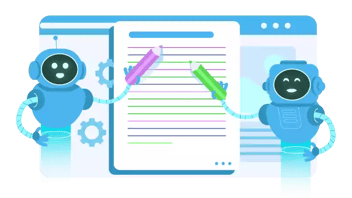What Is Content Readability, And How Can It Be Improved?
Content is undoubtedly king in this digital world. It connects a brand and its audience as a bridge. It helps a business expand reach to a broader range of customers with similar interests. It contributes in many ways, from being a company’s voice to driving quality leads.
However, every write-up doesn’t guarantee engagement, traffic, value, and conversions. Instead, the success of content depends on many factors, and readability is at the top among them. It is a vital ingredient of every piece of written material. It directly affects the quality of your articles, blogs, newsletters, and web content.
That's why it is highly essential to make your content easily readable. However, the question is, what do you need to do to improve readability? Is it all about enhancing language, or must you do something else? Well, the answer to all these questions lies in this article. So, continue reading this article to explore everything.
What Is Content Readability?
Before we delve into learning to enhance readability, let's first understand what it is. It is essential to clarify this concept because many content creators need clarification. Well, if we talk about its definitions, it is simply a measure or estimate of how easy or difficult it is to understand content. In simple words, readability refers to the ease readers feel in processing and digesting information.
It is not about how easy language you use; many other factors influence it. Here are all the main factors that affect it directly:
- Sentence & paragraph length
- Language simplicity
- Content structure
- Flow and tone
- Visual appeal
All things together define the readability of content. A balance of all these ingredients makes an article, blog, or product description easily digestible. Ignoring any of them may make a big difference in content accessibility, costing you less audience retention.
Why Readability Matters In Content?
Making your content readable is all about driving more results from it. The hard-to-read content doesn’t prove fruitful; it wastes time and energy. Here are some solid reasons that indicate the importance of readability in content:
-
Enhanced User Engagement: Brands trying to promote their services or products through content marketing always want users to interact with them. Readable guides, articles, and blog posts help a business keep its audience engaged quickly. If your readers understand content quickly, they are likelier to stay, absorb, and share it.
-
Improved SEO Performance: Search engines prioritize content that offers no understanding issues to readers. They prefer to provide their users with clear, direct, and engaging answers to every query. So, when you consider readability, your content becomes more deserving of appearing in search results, so you always focus on writing SEO-friendly content.
-
Increased Conversion Rates: Content with jargon, poor structure, and other barriers stops readers from acting. When potential customers struggle to grasp your offers, they are less likely to convert. On the other hand, if they comprehend your product's benefits without effort, they don't hesitate to act on calls to action.
-
Higher Trust and Authority: Your communication with your audience shows sincerity. Writing explicit and error-free content indicates that you value your readers' time. When they realize you provide insightful and easily understandable information, they see you as a credible and authoritative content source.
Effective Practices To Make Content More Readable
Here are some essential practices that will help you increase the readability of your content:
Use Simple Language
One of the main factors that impact readability is the language you use. When aiming to make your content clear and free from complications, use simple language. State everything using easy words and accessible sentence structure. Every word you write should contribute to making the material more readable.
Therefore, be careful in your word choice and sentence structure. Instead of using technical terms or jargon, incorporate familiar phrases that everyone can understand easily. The simpler you keep the language, the easier it becomes for readers to digest your message. As a result, the chances of interactions and responses increase significantly.
Keep Sentences And Paragraphs Short
Would you like to read content with lengthy sentences and paragraphs? Most likely, your answer will be no. The same is the behavior of nearly most readers. Lengthier lines and sections frustrate the audience and prevent them from understanding the meanings correctly. Consequently, they leave the site and go for more accessible solutions.
Therefore, keep the sentences and paragraphs shorter. This will help readers grasp the meanings of your message quickly without much effort. Your longest sentence must be between 15 and 20 words. Similarly, aim for 3 to 5 lines in a paragraph, as the ideal length keeps the users engaged.
Write In Active Voice
Sometimes, you inadvertently write many sentences in a passive voice while creating a piece of content. The excess of such lines makes the information more complicated. This is because passive voice involves discussing the object before the subject and the action. This makes it hard for readers to follow the sentence and relate it to the previous one.
Therefore, aim to state all the details in an active voice. This practice makes your message more direct to the audience. This directness improves content flow and makes the content more conversational and approachable. Also, it helps you control the length of sentences, as it takes fewer words to complete a statement in an active voice than a passive one.
Create A Comprehensive Content Structure
The way you structure your content matters when defining its overall readability. Poorly organized articles and blog posts are less likely to capture an audience's attention. On the other hand, well-structured content keeps readers engaged by helping them quickly find relevant information within the content. So, if you wish to create content that readers don't immediately bounce off of, put effort into creating a comprehensive structure.
Divide the topic into easily digestible subheadings and arrange them logically. Use heading tags such as H1, H2, and H3 to organize the information chronologically. Each part of your content must be cohesive, from the introduction to the conclusion. This creates a flow in your writing that helps readers navigate through every section easily.
Utilize Bullets And Lists
Stating everything in paragraph form weakens the strength of your content. Readers who see lengthy sections get overwhelmed and search other sources to find easily readable details. However, they feel comfortable reading and comprehending the meanings when you break down the information into manageable chunks using lists and bullets.
Lists and bullet points help the audience focus on what matters most. They provide quick insights into essential details and create white spaces that make the content appear less complicated and visually appealing. So, use lists and bullet points in your content to convert complex information into simple-to-understand material.
Incorporate Visuals Into Content
Another effective technique for making content more readable is including visuals. When pictures and text are combined to communicate, it proves more impactful. Readers are more likely to read material with meaningful and relevant images. So, enrich it with amazing photos, whether a post, product description, or any type of content.
However, make sure that the visuals you add contribute to the overall understandability of the content. For better results, you can use custom-designed infographics, charts, and tables. You can also source suitable pictures from stock platforms. Whatever image you incorporate in the content, make sure it is royalty-free and placed strategically within sections.
Ensure Lingual Accuracy
Lingual accuracy is a crucial ingredient of readability. Ignoring it can lead to significant confusion in the content. Whether it is a misspelled word or misplaced punctuation, grammatical mistakes produce complexity in the message. Therefore, make sure that you check the entire document for linguistic prevision. This practice brings clarity to your content.
Start from the first line and read all the written information. When going through content, stay vigilant to errors that you mostly make. This is because it is more likely that your material will contain the same mistakes you made in previous write-ups. After identifying errors, make the needed edits immediately to make the content error-free.
Efficient Online Tools To Improve Content Readability
When it comes to improving content readability, manual efforts don't prove sufficient. You must rely on different digital writing assistants to ensure everything you write is readable. Even experienced writers take help from digital tools. Manual efforts combined with online tools prove more beneficial in bringing clarity to content.
However, the question is which tools you should use, as there are many options out there on the Internet. To simplify it, we have listed below some of the best tools to enhance readability in content. So, let's explore what they help you with and what they offer.
1. Paraphrase-online.com
If you wish there could be a tool that helps you improve readability by simplifying language in content, visit www.paraphrase-online.com. It is a trusted paraphraser that makes it easy for you to make your articles and blog posts easy to read. Its strengths lie in restating the unengaging and complicated sentences uniquely and simply. What makes it efficient at rephrasing text is the use of advanced AI algorithms. These algorithms enable this AI paraphrasing tool to analyze every line deeply and make context-based improvements. Here is what exactly it helps you with:
- It helps improve word choice in content.
- Assists in simplifying complex sentence structures.
- Aids in introducing new yet simple vocabulary to text.
- Allows to set the tone of content to maintain a natural flow.
Key Features:
- Permits to paraphrase content freely.
- Can rephrase text in over ten languages.
- Incredibly easy to use for everyone.
2. ProWritingAid
ProWritingAid is another efficient writing assistant that enables you to enhance content readability with less effort. It is famous for accurately identifying structural and linguistic issues in text. It is a one-stop editing solution for all writers looking to make their material easily readable. It comes with many content improvement capabilities, but the most prominent ones are listed below:
- Highlights grammatical issues with suitable suggestions.
- Provides readability score for better text assessment.
- Offers multiple reports to improve style, tone, and structure.
- Identifies redundant words and gives better alternatives.
Key Features:
- A simple user interface makes editing easy.
- Allows setting document type for better text inspection.
- Generates over 25 comprehensive text analysis reports.
3. Hemingway Editor
Hemingway Editor is also a leading tool that reduces the need for manual efforts to improve readability. What sets it apart from others is that it divides the sentences into different categories based on the level of complexity. Then, it highlights each of them with a separate color and provides relevant suggestions for the writers' convenience. It mainly does the following things to help you enhance the clarity of your text:
- It catches sentences that seem very hard to read.
- Spots overuse of passive voice and particular words.
- Finds all the lingual inaccuracies within seconds.
- It makes you aware of misused qualifiers in content.
Key Features:
- Displays a readability grade based on content complexity.
- Integrates AI technology for quick and precise corrections.
- Tells about the estimated reading time for content.
Final Words
Readability is undoubtedly a vital quality factor that needs equal attention as others. A well-written and readable piece of information guarantees engagement and conversions. Maintaining readability is about stating and styling the information in the most digestible way. We have provided some of the most effective tips above. We hope you have reviewed them and will apply them in your subsequent write-up.
This content is also available in:
- German: Was ist die Lesbarkeit von Inhalten, und wie kann ich sie verbessern?
- Spanish: ¿Qué es la legibilidad del contenido y cómo puede mejorarse?
- French: Qu'est-ce que la lisibilité du contenu et comment l'améliorer ?
- Italian: Che cos'è la leggibilità dei contenuti e come si può migliorare?
- Romanian: Ce este lizibilitatea conținutului și cum poate fi îmbunătățită?
- Chinese: 什么是内容可读性,如何提高可读性?

Opinions expressed in this article are those of the guest author. Aspiration Marketing neither confirms nor disputes any of the conclusions presented.









Leave a Comment